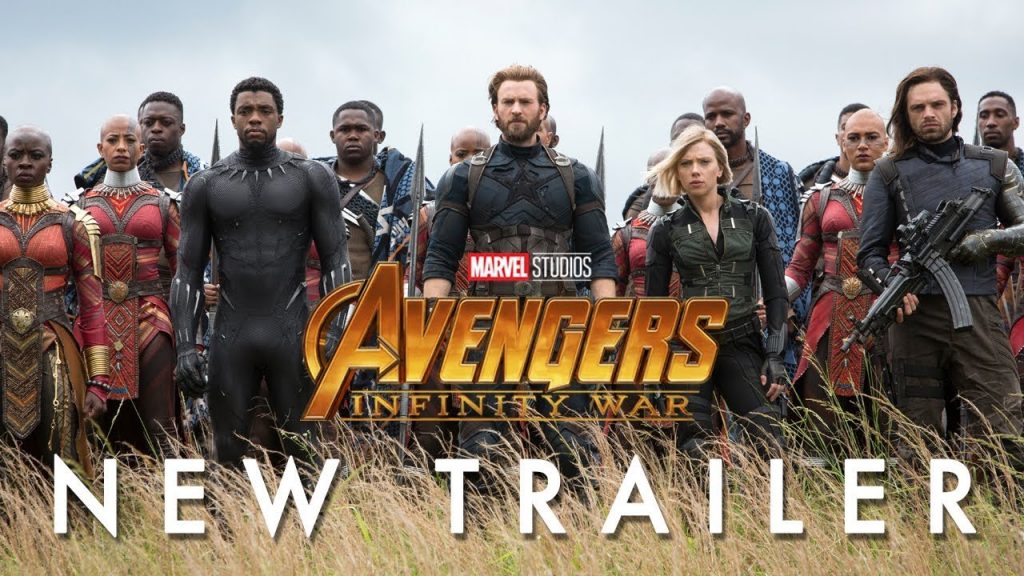
I got into the Marvel universe seven years ago when I watched “Captain America: The First Avenger.” I admit that I was probably living under a rock because until then I had no idea who Chris Evans or Steve Rogers was. Needless to say, I’m very happy with how that movie turned out! Chris Evans is my celebrity crush, and I’ve been a fan of the franchise ever since. In fact, “I can do this all day” is my favorite Marvel/Captain America quote.
Whether you’re a Marvel aficionado, or just discovering the universe, you don’t want to miss “Avengers: Infinity War,” premiering Friday, April 27th. (BTW, have you seen Chris Evans’ beard in the movie trailers? Be still my heart!)

Because there is so much information to remember from the entirety of this comic book/film universe, here is a handy cheat guide to the 18 movies and their relation to the “Avengers: Infinity War” main premise: The Infinity Stones.
Infinity Stones Summarized
https://www.youtube.com/watch?v=TBX4a7WpYqI
Before we get into the movies themselves, I think the best way to start is with an introduction to Infinity Stones. The simplest explanation was given by The Collector in “Guardians of the Galaxy.” Played by a very blonde and haunting Benicio Del Toro, it is quite convincing.
“Before creation itself, there were six singularities, then the universe exploded into existence and the remnants of this system were forged into concentrated ingots. Infinity Stones.”
There are six infinity stones each with its own purpose: Space, Mind, Reality, Power, Soul, and Time. Whoever controls all six stones and activates them together using the Infinity Gauntlet has the power to reshape reality itself.
Over the past 10 years, all Marvel movies and characters have shed light on these stones and their impact/purpose. All of these movies have been, in many ways, leading up to the epic saga that is “Avengers: Infinity War.”
“Iron Man” (2008), “Iron Man 2” (2010), “Iron Man 3” (2013)
Tony Stark’s character evolution is one of my favorites as he continues to push the boundaries of ethics & science with the help of his A.I. sidekick, J.A.R.V.I.S., while risking everything to save Earth. Part philanthropist, part a**hole, he is one of the most conflicted characters besides The Hulk, and arguably one of the most iconic.
“The Incredible Hulk” (2008)
Not part of the new cast of Marvel movies, “The Incredible Hulk” is my least favorite of the movies since it was created before “Iron Man.” Played by Edward Norton (not Mark Ruffalo who is the current Hulk in the movies) it revealed Bruce Banner’s, a Nuclear physicist’s transformation into The Incredible Hulk due to gamma radiation exposure as he tries to recreate a super soldier like Captain America. However, it’s plotline relation to the Infinity Space Stones — and by association, “Avengers: Infinity War” — is quite weak.
I just like Mark Ruffalo so much better as the Hulk. Maybe because when we first see him in the movies, he’s busy being a Hindi-speaking doctor in a small village in India, and gets swindled by a cute little Indian girl. Namaste to you, girl! You just earned yourself a hot, crispy samosa.
“Thor” (2011), “Thor: The Dark World” (2013), “Thor: Ragnarock” (2017)
Thor’s character comes from Viking-like mythology, and it is a glimpse into a superhero from another dimension. Anthony Hopkins plays Odin as the ruler of Asgard, Odin, and Thor’s father, while Tom Hiddleston plays Loki, his adopted brother who is a playful yet dangerous villain with very greasy hair. Natalie Portman plays Jane Foster, Thor’s love interest, and a very smart astrophysicist from Earth with perfect hair.
Jane first interacts with the Reality Stone (Aether) in “Thor: The Dark World,” while it is in a fluid-like state. This stone has the ability to effectively change reality and control individual minds. She is “possessed by it” temporarily, resulting in extremely violent elves arriving at Asgard to steal it. Her hair continues to be perfect through all the fighting.
Of the series, “Thor: Ragnarok” is a must-see with its balance of quirky humor, a wide array of kick-ass characters like the very tough Valkyrie (I had a girl crush on her, so I worry about how much she drinks) and the remarkably sexy evil queen, Hela.
“Captain America: The First Avenger” (2011), “Captain America: The Winter Soldier” (2014), “Captain America: Civil War” (2016)
“The Avengers” (2012), “Avengers: Age of Ultron” (2015)
First mentioned in “Iron Man,” the Avengers initiative begins in these movies after Thor’s brother Loki steals the Space Stone (The Tesseract), to invade Earth. Bringing together Iron Man, Captain America, Thor, the Hulk, and other heroes, The Avengers save Earth from invasion.
“Avengers: Age of Ultron” also introduces the Mind Stone which is capable of creating, manipulating and changing individuals. I recommend watching “Age of Ultron” because it has one of the scariest villains in the movies, in my opinion.
It also debuts a new Avenger, Vision created via The Mind Stone. Vision is a hybrid between artificial intelligence, super strength as well as an almost human-like existence. Vision is positioned to play a pivotal role in “Avengers: Infinity War” due to The Mind Stone that empowers him.
“Guardians of the Galaxy” (2014), “Guardians of the Galaxy Vol. 2” (2017)
Set in outer space, its main character Peter Quill steals the Power stone (the Orb) from an abandoned planet, resulting in an assassin coming after him. Don’t you hate when that happens?
The Guardians of The Galaxy are almost a misfit version of The Avengers including a raccoon, a speaking tree, and a green Joe Saldana. Her character, Gamora, is a tough and fast-moving fighter, and extremely sarcastic. It’s not easy being green but she makes it hot. It’s also important to note that Gamora, one of the Guardians, was raised by Thanos — the all-powerful villain in “Avengers: Infinity War,” and a character we’ve seen throughout the Marvel franchise.
The Power Stone gives the person who wields it the power to destroy an entire planet as its power is proportional to the organic matter it touches. The Power Stone makes the “Guardians of the Galaxy” movies integral to the “Avengers: Infinity War” storyline — and it doesn’t hurt that both films are wildly entertaining.
“Ant-Man” (2015)
“Ant-Man” is extremely fun and shows a different perspective (a smaller perspective, if you will). Scott Lang, the main character, steals the Ant-Man suit without realizing its shrinking technology. Recruited to become Ant-Man and stop the villain, Yellow Jacket, Scott Lang is an unlikely hero.
Played by Paul Rudd (who clearly does not age in real life), this movie is a great precursor to “Captain America: Civil War,” as Ant-Man gets to fight with and against some of the Avengers teammates.
“Doctor Strange” (2016)
Similar in many ways to Iron Man/Tony Stark, Dr. Strange is an arrogant, self-centered, rich neurosurgeon. An accident causing nerve damage to his hands results in a journey of self-discovery, magic, and the Time Stone. You will find yourself forgiving his arrogance because of his British accent and his very well-groomed mustache.
With the Time Stone, he is able to bend space, time and reality – as well as save the Earth from invaders from The Dark Dimension.
“Dr. Strange” is intriguing with its time loop storyline. Although his character’s arc is not as developed as that of Iron Man, his strong desire to save the Earth and the evolution of his abilities become apparent in “Thor: Ragnarok.”
“Spider-Man: Homecoming” (2017)
This is my favorite Spiderman to date. While most of us are quite familiar with the story of Spiderman/Peter Parker, this particular one is very well cast and Peter’s constant desire to connect with Tony Stark is endearing.
Deemed the youngest (and chattiest) Avenger, this is the first time we see Peter Parker as part of the Avengers family. While his direct relation to Infinity Stones isn’t as clear yet, one of my favorite quotes is from Spiderman when speaking to Captain America.
“You’re wrong. You think you’re right. And that makes you dangerous.”
This clearly foreshadows the ominous nature of Thanos, our Marvel universe ultimate big bad. Thanos’ extreme moral code and his perception that he is right and has to save the universe from itself makes him a very dangerous villain.
Black Panther (2018)
There are not enough words to sing the praises of “Black Panther.” Set in the country of Wakanda it is the most beautiful & technologically advanced place hidden from the the outside world. It’s key character, T’Challa, aka The Black Panther, is first seen in “Captain America: Civil War,” where is he is seeking revenge for his father’s death and ends up becoming one of the Avengers. Although not blatantly mentioned, the Soul Stone is suspected to be present in Wakanda due to a meteor hit.
[Read Related: “The Power of ‘Black Panther’ and Its Impact on One Young Brown Woman“]
If you haven’t watched “Black Panther,” do so immediately!
And that’s a wrap! It saddens me to say that because truth be told, I can do this all day. I’ll see you at “Avengers: Infinity War,” and all the Marvel movies beyond. Until then, all my infinite love.




